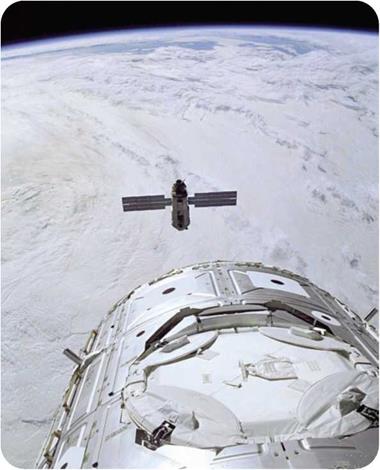The ISS and Space Shuttle
After the Apollo mission, NASA experienced a falling off in public interest in space. The agency also was hampered by financial restraints, and it had to cut back on some programs. In 1975, NASA cooperated with the Soviet space agency to run the Apollo Soyuz Test Project, a joint flight by U. S. and Soviet astronauts. The project foreshadowed today’s cooperation with Russia and other
nations on the International Space Station (ISS). NASA had originally planned to launch its own space station, as authorized by Congress in 1984. Eventually, with costs high and rising, it was decided that an international partnership was more appropriate. The ISS was the successful result of this cooperation, and it has been consistently crewed by a changing group of astronauts since 2000.
In 1981, NASA astronauts flew the first reusable Space Shuttle; in 1983, NASA astronaut Sally K. Ride became America’s first woman in space when she flew on the STS-7 Space Shuttle mission. The Space Shuttle, used to supply the ISS and for satellite launches and other duties, has absorbed much of NASA funding and posed some major challenges since it first flew. It has proved a valuable spacecraft, however.
Two major Space Shuttle accidents caused some critics to question NASA’s safety standards and operational systems. In 1986, Challenger exploded shortly after takeoff, killing all seven crew members. In 2003, Columbia broke up shortly before it was due to land. Again, all seven crew members died. Space Shuttles were grounded after each of these disasters, while NASA and its partners involved in the program investigated the causes. In both cases, a fault was identified and rectified by design changes. The three remaining Space Shuttles were back in operation by 2005.
 О The International Space Station, a cooperative project involving several nations, began with the launches of Russian module Zarya and U. S. module Unity. This photograph shows Unity in the foreground, being delivered by NASA’s Space Shuttle Endeavour for rendezvous with Zarya.
О The International Space Station, a cooperative project involving several nations, began with the launches of Russian module Zarya and U. S. module Unity. This photograph shows Unity in the foreground, being delivered by NASA’s Space Shuttle Endeavour for rendezvous with Zarya.










